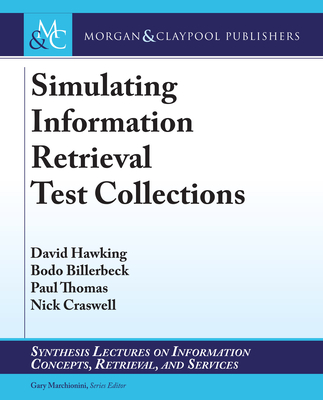Cross-Language Information Retrieval (Paperback)
暫譯: 跨語言資訊檢索 (平裝本)
Jian-Yun Nie
- 出版商: Morgan & Claypool
- 出版日期: 2010-05-07
- 售價: $1,540
- 貴賓價: 9.5 折 $1,463
- 語言: 英文
- 頁數: 142
- 裝訂: Paperback
- ISBN: 1598298631
- ISBN-13: 9781598298635
-
相關分類:
Text-mining
海外代購書籍(需單獨結帳)
買這商品的人也買了...
-
 Apache 錦囊妙技 (Apache Cookbook)
Apache 錦囊妙技 (Apache Cookbook)$580$458 -
 深入淺出設計模式 (Head First Design Patterns)
深入淺出設計模式 (Head First Design Patterns)$880$695 -
 深入淺出 Java 程式設計, 2/e (Head First Java, 2/e)
深入淺出 Java 程式設計, 2/e (Head First Java, 2/e)$880$695 -
 MicroC/OS-II:即時作業系統核心 (MicroC/OS-II: The Real-Time Kernel, 2/e)
MicroC/OS-II:即時作業系統核心 (MicroC/OS-II: The Real-Time Kernel, 2/e)$650$585 -
 JavaScript 學習手冊 (Learning JavaScript)
JavaScript 學習手冊 (Learning JavaScript)$620$490 -
 深入淺出物件導向分析與設計 (Head First Object-Oriented Analysis and Design)
深入淺出物件導向分析與設計 (Head First Object-Oriented Analysis and Design)$880$695 -
 Java 完美經典 (適用 JDK 6.0 版本)
Java 完美經典 (適用 JDK 6.0 版本)$790$672 -
 CCENT/CCNA ICND1 專業認證手冊, 2/e (CCENT/CCNA ICND1 Official Exam Certification Guide (CCENT Exam 640-822 and CCNA Exam 640-802), 2/e)
CCENT/CCNA ICND1 專業認證手冊, 2/e (CCENT/CCNA ICND1 Official Exam Certification Guide (CCENT Exam 640-822 and CCNA Exam 640-802), 2/e)$800$632 -
 密技偷偷報密字第肆拾肆號
密技偷偷報密字第肆拾肆號$199$157 -
 CCNA ICND2 專業認證手冊 (第二版) (CCNA ICND2 Official Exam Certification Guide, 2/e)
CCNA ICND2 專業認證手冊 (第二版) (CCNA ICND2 Official Exam Certification Guide, 2/e)$800$632 -
 Java SE 6.0 視窗程式設計之道
Java SE 6.0 視窗程式設計之道$600$474 -
 jQuery UI 與 plugin 開發實戰 (jQuery UI 1.6: The User Interface Library for jQuery)
jQuery UI 與 plugin 開發實戰 (jQuery UI 1.6: The User Interface Library for jQuery)$550$435 -
 Linux Server 架站實務
Linux Server 架站實務$650$553 -
 Oracle 11g 資料庫管理與維護手冊
Oracle 11g 資料庫管理與維護手冊$490$387 -
 深入淺出 Android 遊戲程式開發範例大全
深入淺出 Android 遊戲程式開發範例大全$620$484 -
 ASP.NET 4.0 專題實務-使用 C#
ASP.NET 4.0 專題實務-使用 C#$750$593 -
 行動裝置嵌入式系統與軟體 (S3C6410 Google Android 2.1 開發應用實務)
行動裝置嵌入式系統與軟體 (S3C6410 Google Android 2.1 開發應用實務)$690$621 -
 跟 Adobe 徹底研究 Flash CS5 (Adobe Flash Professional CS5 Classroom in a Book)
跟 Adobe 徹底研究 Flash CS5 (Adobe Flash Professional CS5 Classroom in a Book)$550$468 -
 演算法之道─讓你學不會演算法都難
演算法之道─讓你學不會演算法都難$420$332 -
 前進 Android Market!Google Android SDK 實戰演練
前進 Android Market!Google Android SDK 實戰演練$850$672 -
 HTML5 在 iPhone/iPad/Android 的應用程式開發實作
HTML5 在 iPhone/iPad/Android 的應用程式開發實作$450$351 -
 用 PC 玩 Android、Mac OS:VMware Workstation 虛擬機器超 IN 用
用 PC 玩 Android、Mac OS:VMware Workstation 虛擬機器超 IN 用$420$332 -
 Google Android SDK 開發範例大全, 3/e
Google Android SDK 開發範例大全, 3/e$950$751 -
 iOS SDK 4 / Xcode 4 應用程式開發範例集-for iPhone/iPad/iPod touch
iOS SDK 4 / Xcode 4 應用程式開發範例集-for iPhone/iPad/iPod touch$450$351 -
 MIS 網管實戰寶典:Linux 老鳥這樣搞定機房大小事
MIS 網管實戰寶典:Linux 老鳥這樣搞定機房大小事$450$383
相關主題
商品描述
Search for information is no longer exclusively limited within the native language of the user, but is more and more extended to other languages. This gives rise to the problem of cross-language information retrieval (CLIR), whose goal is to find relevant information written in a different language to a query. In addition to the problems of monolingual information retrieval (IR), translation is the key problem in CLIR: one should translate either the query or the documents from a language to another. However, this translation problem is not identical to full-text machine translation (MT): the goal is not to produce a human-readable translation, but a translation suitable for finding relevant documents. Specific translation methods are thus required. The goal of this book is to provide a comprehensive description of the specifi c problems arising in CLIR, the solutions proposed in this area, as well as the remaining problems. The book starts with a general description of the monolingual IR and CLIR problems. Different classes of approaches to translation are then presented: approaches using an MT system, dictionary-based translation and approaches based on parallel and comparable corpora. In addition, the typical retrieval effectiveness using different approaches is compared. It will be shown that translation approaches specifically designed for CLIR can rival and outperform high-quality MT systems. Finally, the book offers a look into the future that draws a strong parallel between query expansion in monolingual IR and query translation in CLIR, suggesting that many approaches developed in monolingual IR can be adapted to CLIR. The book can be used as an introduction to CLIR. Advanced readers can also find more technical details and discussions about the remaining research challenges in the future. It is suitable to new researchers who intend to carry out research on CLIR.
商品描述(中文翻譯)
搜尋資訊不再僅限於使用者的母語,而是越來越多地擴展到其他語言。這引發了跨語言資訊檢索(Cross-Language Information Retrieval, CLIR)問題,其目標是找到用不同語言撰寫的與查詢相關的資訊。除了單語資訊檢索(Information Retrieval, IR)所面臨的問題外,翻譯是CLIR中的關鍵問題:必須將查詢或文件從一種語言翻譯成另一種語言。然而,這個翻譯問題並不等同於全文機器翻譯(Machine Translation, MT):其目標不是產生可供人類閱讀的翻譯,而是產生適合於尋找相關文件的翻譯。因此,需要特定的翻譯方法。本書的目的是提供對CLIR中出現的特定問題的全面描述、該領域提出的解決方案以及剩餘的問題。本書首先對單語IR和CLIR問題進行一般性描述。然後介紹不同類別的翻譯方法:使用MT系統的方式、基於字典的翻譯以及基於平行和可比語料庫的方法。此外,還比較了使用不同方法的典型檢索效果。將顯示專為CLIR設計的翻譯方法可以與高品質的MT系統相媲美並超越它們。最後,本書展望未來,強調單語IR中的查詢擴展與CLIR中的查詢翻譯之間的密切關聯,建議許多在單語IR中開發的方法可以適應於CLIR。本書可作為CLIR的入門書籍。進階讀者也可以找到更多技術細節和關於未來剩餘研究挑戰的討論。適合有意從事CLIR研究的新研究者。











